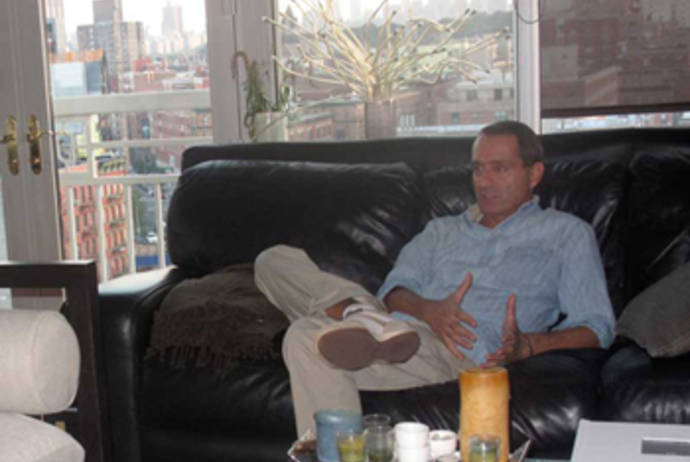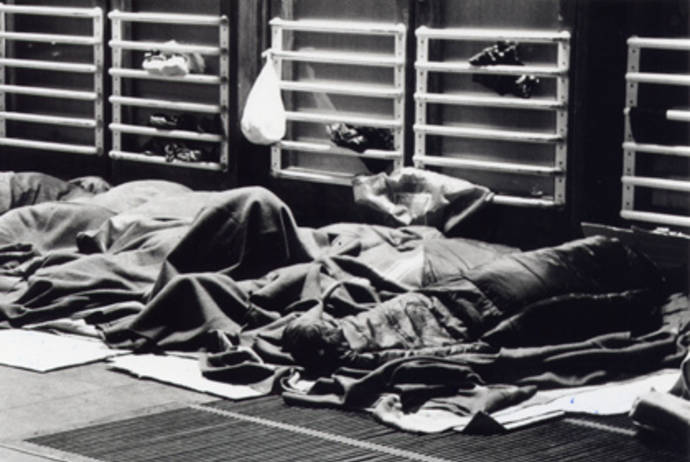We met him in his home-office in Harlem. From his window our glance bounces from roof to roof, from Harlem to the skyscrapers of Midtown. He is the man who brought Morricone and Benigni to America, and after many years of trying he made Pino Daniele’s concert possible.
But these are just the latest in Massimo Gallotta’s career as a music producer and so much more.
And so we spend our visit with him, coffee in front of us while night falls and the buildingsaround us light up. A few of his memories reflect on the presence of Italian music in New York.
“I’ve been here since 2002 with the intention of organizing concerts. After the event with Ennio Morricone, which was incredibly successful, the number of American offers grew and so I structured a collaborative effort between Italy and the U.S. to produce music events.”
All of the events until now have had his particular touch… “Yes, I concentrated on difficult events, challenging ones from an organizational point of view. There were some that had been anticipated for years, but I think they required special arrangements.”
“In recent years there have been various Italian artists who have appeared for the first time in New York. It seems like a magic moment for our music after a long time. Our music has had difficulty crossing over and overcoming a certain stereotypical image that is associated with traditional Italian melodies.”
Is it truly as good a time as it seems for our music?
“Yes, but why, I don’t know. I tried to read what the public wants here. There is a pressing need to understand more about the current musical landscape. Obviously, I mean live music productions that I’m involved with. It’s been said that it’s risky to come to American and, in fact, even though many have tried sporadically they have haven’t found the right protection and location in this market. A different approach must be used, and to do so a commitment to understanding the business is required.”
What are the qualities one needs to be in your line of work?
“Imagination, but also strong motivation. There is also a lot of competition, but when you have very clear ideas and you succeed in bringing them to the right places, your success is assured.”
Massimo has been in this business for 35 years. He was there behind many music events that have made history in Italy. Entering the American world was not by any means easy for him. It certainly involved courageous choices even after solid success in Italy.
“Integrating oneself into the work world here takes time and effort. The business rules here are very different. We are in the motherland of entertainment. It’s different situation here, bringing Italian artists and promoting them with success, especially promotion that requires sophisticated logistics so the artists are presented to the American public in the best possible way. The artists are followed in every detail with a real physical presence...”
How does Massimo Gallotta Productions work? Is it a big company?
“There are six of us and obviously I have a support system in Italy that helps me to organize the moves and transfers, and resolve visa problems for the technicians and the artists. And then there are external firms that I consult for advice.”
Despite the relaxed and cordial atmosphere and a decidedly sunny air, Massimo’s demeanor is one of a true professional who knows his business. He is even meticulous in his explanations. On promotional channels he says: “I usually use both the Italian as well as the American ones. It’s been said that the American ones are more effective. So, we use the New York Times, TimeOut New York… It depends, of course, on the type of artist.
For example, this time with Pino Daniele we pushed it more in the community with a few nods in the American press. With Benigni and Morricone the promotion was more ‘American.’”
He quickly elaborates: “This is Pino Daniele’s first concert. With him, as I did with other artists, I made an atypical choice to introduce him. An Italian artist has never played the Apollo. It’s the signature theater in Harlem.
In this place there is not only the infrastructure for music, but there is a tradition of music, of African-American music, jazz, and other kinds of music. It’s a theater that makes headlines. Pino Daniele understood this immediately. It’s a theater that affects an artist’s career. And for me an artist truly understands when the right moment is and when the proposal is interesting.”
So how did this concert come about?
“I tried to convince him for four years. At first I didn’t think of the Apollo. I discovered this location with Patti LaBelle’s concert. A big night. And I really liked the atmosphere. Harlem has been changing for a long time. It’s alive. I also looked for an historic theater for Benigni’s show. [Daniele] will do the same Italian concert. It’s very beautiful. It’s already a success in terms of the number of reservations, and I hope that he will explore the possibility of also experimenting here in America. He will play with his Italian group and two American musicians.”
Gallotta began this work at a very young age. In 1976 he organized a concert in his hometown by chance. After this, there was another, and another, and still another. In the end it became his job and the good fortune for many musicians.
From there, he went on to work with Frank Sinatra, Ray Charles, the Manhattan Transfer, Gilbert Becaud, Gilbert Gil, Lina Sastri, Gianni Morandi, Renzo Arbore, Lucio Dalla, Gigi Proietti. There are so many artists that he followed, names that belong to the history of international music. Even Renato Carosone. We cannot help but ask him some details about his encounter with the man who sang “Tu vo fa l'americano….”
“Yes at twenty years old I became Renato Carosone’s manager. A long story… I wanted this with all my might. He had retired from the scene and didn’t want to play live. I asked him for a meeting which he kindly accepted. I remember entering his beautiful villa at the wheel of a borrowed car. I didn’t even have my learner’s permit. He met with me as a courtesy. I told him, ‘Maestro, I want to promote your concerts!’ He gently responded that he could not. ‘I have to study and I study eight hours a day!’ I didn’t lose heart. I sought after him and after some time I convinced him. He did two solo concerts and then it took off. Viareggio, Montecarlo...and many others. I became his confidant, the person he trusted. The personal approach is usually successful with artists. They need to trust you.”
He has so much to tell…and i-Italy will soon return to visit him again. He currently has a
project underway with Renzo Arbore…and many others.
“Today I’m no longer interested in being a manager in the traditional sense. I’d like to be able to completely dedicate myself to an event, to organize the details. I have different responsibilities. I work on innovation, on a variety of things. I like to work on an artist’s first debut and create an event to generate interest. I do this with many artists and not only those who are connected to Italy. I promote Italian music as well as American music in Italy.”
The secret? “Every event needs to be unique for me.”
And we would like to conclude his profile by quoting a sentence from the bio on his website.
“Above all I have to thank my Parents who right from the beginning of my career have given me a hard time, teaching me to never avoid the hard times, but rather to proceeding with the strongest determination to complete what I truly believe in.”
The Concert of Pino Daniele will be on October 1st 8.00 pm at the Apollo -253 West 125th Street, New York



































 that constantly shifts between moments of attraction and repulsion. The entire monologue is a brilliantly improvised crescendo during which the Italian-American experience transcends ethnic boundaries and assumed universal characteristics.
that constantly shifts between moments of attraction and repulsion. The entire monologue is a brilliantly improvised crescendo during which the Italian-American experience transcends ethnic boundaries and assumed universal characteristics. y frantically attempt to meet each other at times so they could find a possible compromise. For example, the mother insists on sewing curtains for her daughter but she wants nothing to do with them at first. Eventually the daughter gives in; she will have curtains on her window (a symbol of her mother's skill as a parent "There can't be windows without curtains!"). But, the daughter's curtains will not be decorated with purple lines and polka dots. They will be white...
y frantically attempt to meet each other at times so they could find a possible compromise. For example, the mother insists on sewing curtains for her daughter but she wants nothing to do with them at first. Eventually the daughter gives in; she will have curtains on her window (a symbol of her mother's skill as a parent "There can't be windows without curtains!"). But, the daughter's curtains will not be decorated with purple lines and polka dots. They will be white...


 He told us that he had been waiting for years to assist in the spontaneous creation “from the bottom” of the first nodes of that network, and singled out i-Italy.org as one of them. We were flattered by his appreciation: we were aware that Piero Bassetti had been working for years on the theme of Italicity. We also knew that he approaches it in a provocative way—outside of the classical schemes, relieved from the inflated registers sometimes utilized in institutional discourse, and also from the most common stereotypes.
He told us that he had been waiting for years to assist in the spontaneous creation “from the bottom” of the first nodes of that network, and singled out i-Italy.org as one of them. We were flattered by his appreciation: we were aware that Piero Bassetti had been working for years on the theme of Italicity. We also knew that he approaches it in a provocative way—outside of the classical schemes, relieved from the inflated registers sometimes utilized in institutional discourse, and also from the most common stereotypes.

 ction
ction 
 zzare i commercianti a non pagare il pizzo. I giovani oggi hanno come eroi Falcone e Borsellino. Si l’Arma dei Carabinieri come simbolo di una Sicilia che impegna tante risorse nella legalità e nell’educazione alla legalità.”
zzare i commercianti a non pagare il pizzo. I giovani oggi hanno come eroi Falcone e Borsellino. Si l’Arma dei Carabinieri come simbolo di una Sicilia che impegna tante risorse nella legalità e nell’educazione alla legalità.”

 el of hospitality. Even the smallest places provide warm hospitality with all of the services that a tourist could want.
el of hospitality. Even the smallest places provide warm hospitality with all of the services that a tourist could want.

